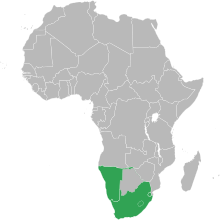Common Monetary Area
The Common Monetary Area ( CMA ; German about Unified area ) is a monetary union in southern Africa , led by the South African central bank (SARB). It was founded in 1986 between South Africa , Lesotho and Swaziland , replacing an older de facto currency union in southern Africa.
The CMA is closely linked to the Customs Union of Southern Africa (SACU). Only Botswana is a member of the SACU, not the CMA. Namibia joined in 1992.
history
The Common Monetary Area goes back to an older, de facto monetary union in southern Africa. After the establishment of the South African Central Bank (SARB) in 1921, the currency of the South African Union (later South Africa) became legal tender in Basutoland (Lesotho), Swaziland, Bechuanaland (Botswana) and the Mandate Area of South West Africa ; there were no cross-border restrictions. The currency was the South African pound until 1961 and has been the rand since then .
The South African currency and the sole administration of this by the SARB continued after the independence of Basutoland (as Lesotho), Swaziland and Bechuanaland (as Botswana) in the 1960s. A currency union was formally created between these countries on December 5, 1974 with the Rand Monetary Area (RMA). Botswana left Botswana just a year later, driven by the desire to pursue an independent monetary policy.
When Swaziland introduced the Lilangeni in 1974 with its own Central Bank of Swaziland and Lesotho introduced the Loti as its own currencies in 1980 with the Central Bank of Lesotho , their exchange rate to the Rand was fixed at 1: 1. The rand remained legal tender in these countries. In order to take account of these new circumstances, the three countries South Africa, Swaziland and Lesotho founded the Common Monetary Area in April 1986 , in which the right to national currencies with exchange rate parity to the edge is established. Lesotho then abolished the rand as legal tender, although the rand was still in use in the country. It was not until autumn 2003 that the rand became legal tender again in Lesotho.
After its independence from South Africa in 1990, Namibia joined the CMA in 1992.
Institutional framework
The CMA aims at a balanced economic development that encompasses all member countries. In addition, the rise of the weaker states of the CMA is to be driven forward in such a way that all member states benefit equally from the agreement.
According to Article 2 of the CMA Treaty, all member countries have the right to issue their own currencies. This ( Lesotho Loti , Namibian dollars and Eswatininischer Lilangeni ) are with exchange rate parity to the South African rand coupled. The rand is also legal tender in all countries. Accordingly, the Central Bank of South Africa has the role of central bank for the entire CMA. South Africa compensates the member countries for the lost coin profit from the coinage according to a formula set out in the contract.
Article 3 of the CMA Treaty prohibits all restrictions on the movement of money and capital in the member countries. Only state investments are excluded.
Article 5 of the CMA treaty stipulates that gold and foreign exchange transactions must be similar in their legal form to those in South Africa. Furthermore, according to Article 9, an arbitration tribunal may be set up to resolve contractual disputes between the countries.
literature
- Jian-Ye Wang, Iyabo Masha, Kazuko Shirono, Leighton Harris: The Common Monetary Area in Southern Africa: Shocks, Adjustment, and Policy Challenges . In: IMF Working Paper Series . No. 07/158 , July 1, 2007 (English, imf.org [PDF]).
